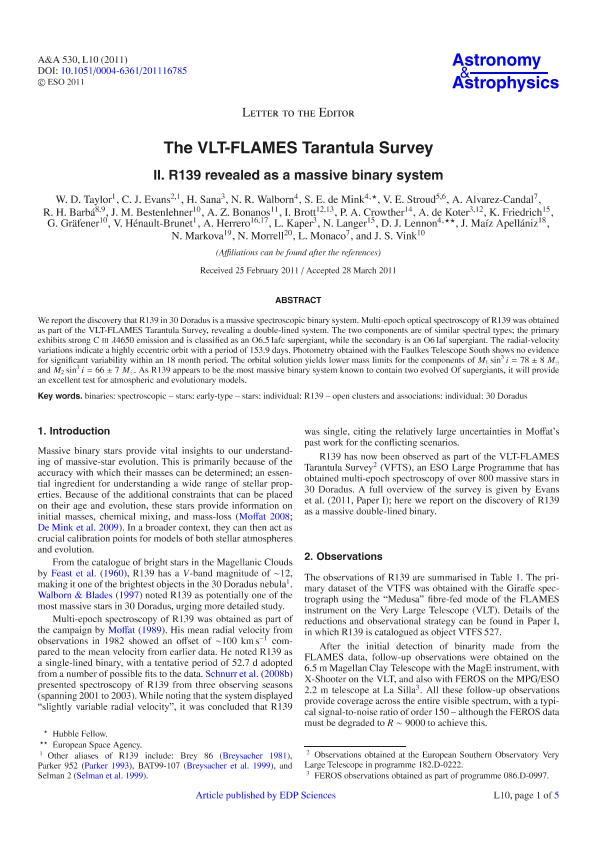Mostrar el registro sencillo del ítem
dc.contributor.author
Taylor, W. D.
dc.contributor.author
Evans, C. J.
dc.contributor.author
Sana, H.
dc.contributor.author
Walborn, N. R.
dc.contributor.author
de Mink, S. E.
dc.contributor.author
Stroud, V. E.
dc.contributor.author
Alvarez Candal, A.
dc.contributor.author
Barba, Rodolfo Hector

dc.contributor.author
Bestenlehner, J. M.
dc.contributor.author
Bonanos, A. Z.
dc.contributor.author
Brott, I.
dc.contributor.author
Crowther, P. A.
dc.contributor.author
de Koter, A.
dc.contributor.author
Friedrich, K.
dc.contributor.author
Grafener, G.
dc.contributor.author
Henault Brunet, V.
dc.contributor.author
Herrero, A.
dc.contributor.author
Kaper, L.
dc.contributor.author
Langer, N.
dc.contributor.author
Lennon, D. J.
dc.contributor.author
Maiz Apellaniz, J.
dc.contributor.author
Markova, N.
dc.contributor.author
Morrell, Nidia Irene

dc.contributor.author
Monaco, L.
dc.contributor.author
Vink, J.
dc.date.available
2017-02-14T18:07:01Z
dc.date.issued
2011-06
dc.identifier.citation
Taylor, W. D.; Evans, C. J.; Sana, H.; Walborn, N. R.; de Mink, S. E.; et al.; The VLT-FLAMES Tarantula Survey. II. R139 revealed as a massive binary system; Edp Sciences; Astronomy And Astrophysics; 530; 6-2011; 10-13
dc.identifier.issn
0004-6361
dc.identifier.uri
http://hdl.handle.net/11336/12980
dc.description.abstract
We report the discovery that R139 in 30 Doradus is a massive spectroscopic binary system. Multi-epoch optical spectroscopy of R139 was obtained as part of the VLT-FLAMES Tarantula Survey, revealing a double-lined system. The two components are of similar spectral types; the primary exhibits strong C III λ4650 emission and is classified as an O6.5 Iafc supergiant, while the secondary is an O6 Iaf supergiant. The radial-velocity variations indicate a highly eccentric orbit with a period of 153.9 days. Photometry obtained with the Faulkes Telescope South shows no evidence for significant variability within an 18 month period. The orbital solution yields lower mass limits for the components of M1sin3i = 78 ± 8 M⊙ and M2sin3i = 66 ± 7 M⊙. As R139 appears to be the most massive binary system known to contain two evolved Of supergiants, it will provide an excellent test for atmospheric and evolutionary models.
dc.format
application/pdf
dc.language.iso
eng
dc.publisher
Edp Sciences

dc.rights
info:eu-repo/semantics/openAccess
dc.rights.uri
https://creativecommons.org/licenses/by-nc-sa/2.5/ar/
dc.subject
Binaries
dc.subject
Early-Type Stars
dc.subject
Open Clusters
dc.subject
Associations
dc.subject.classification
Astronomía

dc.subject.classification
Ciencias Físicas

dc.subject.classification
CIENCIAS NATURALES Y EXACTAS

dc.title
The VLT-FLAMES Tarantula Survey. II. R139 revealed as a massive binary system
dc.type
info:eu-repo/semantics/article
dc.type
info:ar-repo/semantics/artículo
dc.type
info:eu-repo/semantics/publishedVersion
dc.date.updated
2017-02-13T20:29:39Z
dc.journal.volume
530
dc.journal.pagination
10-13
dc.journal.pais
Francia

dc.journal.ciudad
Paris
dc.description.fil
Fil: Taylor, W. D.. Royal Observatory Edinburgh; Reino Unido
dc.description.fil
Fil: Evans, C. J.. Royal Observatory Edinburgh; Reino Unido
dc.description.fil
Fil: Sana, H.. University Of Amsterdam; Países Bajos
dc.description.fil
Fil: Walborn, N. R.. Space Telescope Science Institute; Estados Unidos
dc.description.fil
Fil: de Mink, S. E.. Space Telescope Science Institute; Estados Unidos
dc.description.fil
Fil: Stroud, V. E.. The Open University; Reino Unido. University of Glamorgan; Reino Unido
dc.description.fil
Fil: Alvarez Candal, A.. European Southern Observatory; Chile
dc.description.fil
Fil: Barba, Rodolfo Hector. Universidad de la Serena; Chile. Consejo Nacional de Investigaciones Cientificas y Tecnicas. Centro Cientifico Tecnologico San Juan. Instituto de Ciencias Astronomicas de la Tierra y del Espacio; Argentina
dc.description.fil
Fil: Bestenlehner, J. M.. Armagh Observatory; Irlanda
dc.description.fil
Fil: Bonanos, A. Z.. National Observatory of Athens; Grecia
dc.description.fil
Fil: Brott, I.. Utrecht Univeristy; Países Bajos. University of Vienna; Austria
dc.description.fil
Fil: Crowther, P. A.. University of Sheffield; Reino Unido
dc.description.fil
Fil: de Koter, A.. Utrecht Univeristy; Países Bajos. University Of Amsterdam; Países Bajos
dc.description.fil
Fil: Friedrich, K.. Argelander-Unstitut fur Astronomie der Universitat Bonn; Alemania
dc.description.fil
Fil: Grafener, G.. Armagh Observatory; Irlanda
dc.description.fil
Fil: Henault Brunet, V.. Royal Observatory Edinburgh; Reino Unido
dc.description.fil
Fil: Herrero, A.. Instituto de Astrofísica de Canarias; España. Universidad de la Laguna; España
dc.description.fil
Fil: Kaper, L.. University Of Amsterdam; Países Bajos
dc.description.fil
Fil: Langer, N.. Argelander-Unstitut fur Astronomie der Universitat Bonn; Alemania
dc.description.fil
Fil: Lennon, D. J.. Space Telescope Science Institute; Estados Unidos
dc.description.fil
Fil: Maiz Apellaniz, J.. Consejo Superior de Investigaciones Cientificas. Instituto de Astrofísica de Andalucía; España
dc.description.fil
Fil: Markova, N.. Bulgarian Academy of Sciences. National Astronomical Observatory; Bulgaria
dc.description.fil
Fil: Morrell, Nidia Irene. Las Campanas Observatory; Chile
dc.description.fil
Fil: Monaco, L.. European Southern Observatory; Chile
dc.description.fil
Fil: Vink, J.. Armagh Observatory; Irlanda
dc.journal.title
Astronomy And Astrophysics

dc.relation.alternativeid
info:eu-repo/semantics/altIdentifier/url/http://www.aanda.org/articles/aa/abs/2011/06/aa16785-11/aa16785-11.html
dc.relation.alternativeid
info:eu-repo/semantics/altIdentifier/doi/http://dx.doi.org/10.1051/0004-6361/201116785
dc.relation.alternativeid
info:eu-repo/semantics/altIdentifier/url/https://arxiv.org/abs/1103.5387
Archivos asociados
